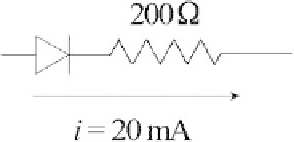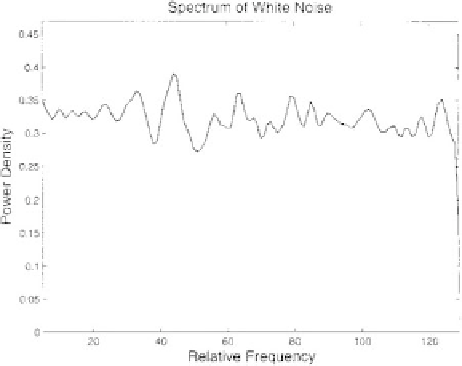Biomedical Engineering Reference
In-Depth Information
In practice, there will be limits imposed on the fre-
quencies present within any waveform (including noise
waveforms), and these limits are used to determine
band width. In the problems given here the bandwidth
is simply stated. Bandwidth is usually specified in hertz
with units of inverse seconds (i.e., 1/second). Because
bandwidth is not always known in advance, it is
common to describe a relative noise, specifically the
noise that would occur if the bandwidth were 1.0 Hz.
Such relative noise specification can be identified by the
unusual units required: V
=
H
p
.
Shot noise is defined as a current noise and is pro-
portional
p
or ampere
ð
A
Þ=
Hz
to
the
baseline
current
through
a
semi-
conductor junction:
Figure 2.3-11 A plot of the energy in white noise as a function of
frequency. The noise has a flat spectral characteristic showing
similar energy levels over a wide range of all frequencies plotted.
This equal-energy characteristic gives rise to the term white noise.
I
s
¼
p
2
qI
d
BW
amps
[Eq. 2.3.10]
where
q
is the charge on an electron (1.602
10
19
coulomb [coul]), and
I
d
is the baseline semiconductor
current. (In photodetectors, the baseline current that
generates shot noise is termed the
dark current,
hence
the letter
d
in the current symbol,
I
d
in Eq. 2.3.10.)
Again, the noise is spread across all frequencies so the
bandwidth must be specified to obtain a specific value, or
where
R
is the resistance in ohms,
T
the temperature in
kelvin, and
k
Boltzmann's constant (
k ¼
1.38
10
23
joules/kelvin). (A temperature of 310 K is often used as
room temperature, in which case 4
kT¼
1.7
10
20
J.)
Here
BW
is the range of frequencies that is included in
the signal. This range of frequencies is termed
band-
width
. This frequency range is usually determined by the
characteristics of the measurement system, often the
filters used in the system. Because Johnson noise is
spread over all frequencies, the greater the signal's
bandwidth, the greater the noise in any given signal.
If noise current is of interest, the equation for Johnson
noise current can be obtained from Eq. 2.3.8 in con-
junction with Ohm's law:
a relative noise can be specified in A
=
p
.
When multiple noise sources are present, as is often
the case, their voltage or current contributions add to the
total noise as the square root of the sum of the squares,
assuming
Hz
that
the
individual
noise
sources
are
in-
dependent. For voltages:
q
V
1
þ V
2
þ V
3
þ
.
þ V
N
q
4
k TBW=R
V
T
¼
[Eq. 2.3.11]
I
J
¼
amps
[Eq. 2.3.9]
A similar equation applies to current noise.
Example 2.3.5: A 20-mA current flows through a diode
(i.e., a semiconductor) and a 200-
U
resistor. What is the
net current noise,
i
n
? Assume a bandwidth of 1 MHz (1
10
6
Hz).
Table 2.3-3 Sources of variability
Source
Cause
Potential
remedy
Physiological
variability
Measurement
only indirectly
related to variable
of interest
Modify overall
approach
Environmental
(internal or
external)
Other sources of
similar energy form
Noise cancellation
Transducer design
Artifact
Transducer responds to
other energy sources
Transducer design
Solution:
Find the noise contributed by the diode using
Eq. 2.3.10, the noise contributed by the resistor using
Eq. 2.3.9, then combine them using Eq. 2.3.11.
Electronic
Thermal or shot noise
Transducer or
electronic design















